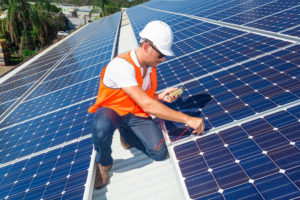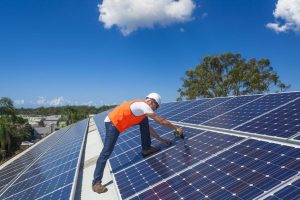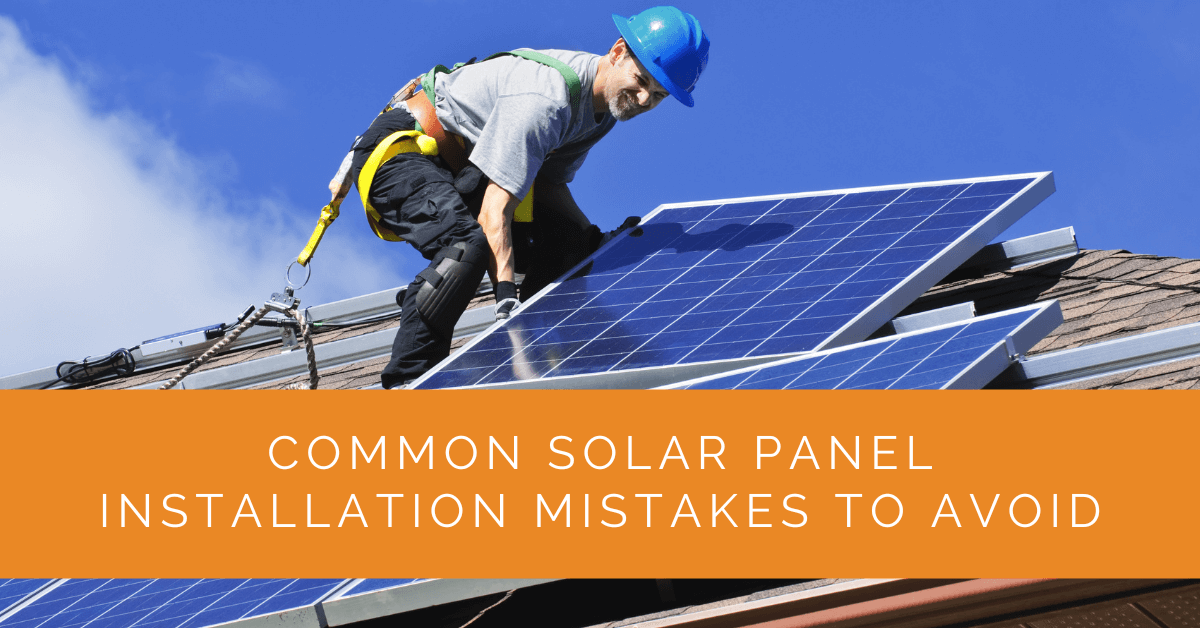Proper installation is crucial for your solar panel system’s optimal performance and longevity. Avoiding common installation mistakes can save you time, and money, and ensure you get the most out of your solar investment. This article will explore the seven most common solar panel installation mistakes and provide insights on how to avoid them.
Contents
- 1 1. Poor System Design
- 2 2. Improper Panel Placement
- 3 3. Insufficient Number of Panels
- 4 4. DIY Solar Panel Installation
- 5 5. Ignoring Manufacturer Guidelines
- 6 6. Choosing the Cheapest Solar Panels
- 7 7. Neglecting Warranty Considerations
- 8 Case Study: Ensuring Optimal Performance by Avoiding Common Installation Mistakes
- 9 Expert Insights From Our Solar Panel Installers About Common Solar Panel Installation Mistakes to Avoid
- 10 Experience Solar Excellence with Us!
- 11 Conclusion
1. Poor System Design
Understanding the Impact of System Design on Performance
A well-thought-out system design is one of the most critical aspects of a successful solar panel installation. The design directly influences your solar energy system’s performance, efficiency, and longevity. A poorly designed system can result in suboptimal energy production, decreased output, and potential issues.
To avoid this common mistake, working with an experienced solar installer or design professional who can conduct a thorough site assessment is crucial. They will consider the available space, shading patterns, sun orientation, and electrical layout. By carefully analyzing these aspects, they can create a design that maximizes the system’s efficiency and aligns with your energy goals.
Mistakes to Avoid in System Design
Some mistakes that homeowners should avoid when it comes to system design include the following:
- Neglecting proper site assessment: Skipping or rushing through a comprehensive site assessment can lead to poor panel placement, inefficient energy production, and increased shading issues. It’s essential to assess the site thoroughly to determine the most optimal location for your solar panels.
- Overlooking the electrical layout: The electrical layout of a solar panel system is just as important as the physical placement of the panels. Neglecting to properly size or design electrical components, such as the inverter, can result in compatibility issues or reduced system performance. Working with a professional ensures that the electrical layout is appropriately designed to support your household’s energy production and electrical demands.
Taking the time to consider and address these design aspects carefully will result in a well-optimized solar energy system that performs efficiently and meets your energy needs effectively.
2. Improper Panel Placement
The Significance of Correctly Positioning Solar Panels
Proper panel placement is a crucial factor that significantly impacts your solar panel system’s overall energy generation and efficiency. It involves carefully considering the sun’s path, shade patterns, and orientation to ensure optimal sunlight exposure throughout the day.
Mistakes to Avoid in Panel Placement
To avoid improper panel placement, it’s essential to steer clear of the following mistakes:
- Placing panels away from the sun’s path: One common mistake is installing solar panels in shaded areas for a significant portion of the day. Even partial shading can significantly impact the energy production of the entire system. It is crucial to assess the site carefully and position the panels where they receive maximum sunlight exposure throughout the day.
- Incorrect orientation: Another mistake to avoid is failing to align the solar panels correctly based on the site’s latitude. Proper orientation ensures that the panels capture the most sunlight throughout the year, maximizing energy production. Aligning the panels towards the south in the northern hemisphere or north in the southern hemisphere is generally the most effective orientation for solar energy generation.
By paying attention to these placement considerations and avoiding these common mistakes, you can optimize the sun’s energy capture and ensure that your solar panel system operates at its highest potential.

3. Insufficient Number of Panels
Calculating the Proper Number of Panels for Your Energy Needs
Determining the appropriate number of solar panels for your installation is essential to meet your energy requirements and maximize the system’s performance. Insufficient panel quantity can result in an underperforming system that fails to generate enough electricity to meet your household’s needs.
Mistakes to Avoid in Panel Quantity
To avoid falling short on panel quantity, consider the following mistakes:
- Not considering energy consumption: One common mistake is failing to accurately assess your current and future energy needs. Evaluating your household’s electricity consumption patterns, including peak usage times and seasonal variations, is crucial. This information helps determine the appropriate panel quantity required to generate enough electricity to meet your yearly demand.
- Ignoring local weather conditions: Another mistake to avoid is overlooking the variations in sunlight intensity throughout the year. Different regions experience varying weather patterns and seasonal changes that can affect the sunlight available for solar energy generation. Failing to account for these variations can result in insufficient panels to compensate for lower output during cloudy days or winter months.
To ensure you have a sufficient number of panels, it is recommended to work with a solar installer or energy professional who can thoroughly assess your energy needs and factor in local weather conditions. By considering your specific energy consumption and the climate in your area, they can determine the optimal number of panels required to meet your energy goals consistently.
By avoiding the mistake of insufficient panel quantity, you can ensure that your solar panel system operates at its full potential, maximizing energy production and providing you with the desired electricity savings.
4. DIY Solar Panel Installation
Considerations Before Undertaking a DIY Solar Panel Installation
The idea of a DIY solar panel installation may appeal to some homeowners due to potential cost savings and the satisfaction of doing it themselves. However, it’s crucial to consider several factors before embarking on a DIY installation.
Mistakes to Avoid in DIY Installations
To avoid potential pitfalls in a DIY solar panel installation, keep these mistakes in mind:
- Lack of expertise: Installing solar panels requires electrical wiring, panel mounting, and system configuration knowledge. Lack of experience or expertise can lead to errors in wiring connections, poor panel placement, and safety hazards. It’s important to assess your skill level and determine if you have the necessary expertise to perform a successful installation.
- Failure to comply with local regulations: DIY installers may overlook the permit requirements and installation guidelines set by local authorities. Non-compliance can lead to legal and safety issues. Researching and understanding your area’s regulations and guidelines before starting the installation process is crucial.
While a DIY solar panel installation may seem appealing, weighing the potential risks and challenges against the benefits is important. Working with a professional solar installer ensures a safe and efficient installation that complies with regulations and maximizes the performance of your solar panel system.

5. Ignoring Manufacturer Guidelines
The Importance of Following Manufacturer Guidelines
Manufacturers provide specific instructions and guidelines for installing solar panels to ensure optimal performance, safety, and warranty coverage. Ignoring these guidelines can lead to suboptimal system efficiency and potential warranty issues.
Mistakes to Avoid Regarding Manufacturer Guidelines
To avoid pitfalls related to manufacturer guidelines, consider the following mistakes:
- Improper handling and storage: Failing to follow the manufacturer’s recommendations for panel handling and storage can damage the panels, reducing their efficiency and lifespan. Following the guidelines for transporting, storing, and unpacking the panels is important to ensure their integrity.
- Non-compliant mounting methods: Solar panels require secure and proper mounting to ensure stability and longevity. Deviating from the manufacturer’s recommended mounting methods or using unauthorized mounting techniques can compromise the integrity of the panels and the overall system. It’s essential to adhere to the manufacturer’s guidelines for mounting the panels to maintain their performance and warranty coverage.
By following the manufacturer’s guidelines, you can ensure that your solar panel system operates as intended, maximizing energy production and maintaining warranty coverage for peace of mind.
6. Choosing the Cheapest Solar Panels
Understanding the Pitfalls of Choosing Based on Price Alone
Cost is an important consideration when selecting solar panels, but solely focusing on the cheapest option can lead to compromised quality, shorter lifespan, and reduced system performance.
Mistakes to Avoid in Panel Selection
To avoid the potential drawbacks of choosing solely based on price, consider these mistakes:
- Sacrificing quality for cost: Opting for the cheapest solar panels without considering their quality, efficiency, and warranty coverage can result in subpar performance and premature system failure. Ignoring long-term savings: Cheaper panels may have lower energy output and efficiency, leading to reduced savings on your electricity bills over the system’s lifetime. Considering the long-term financial benefits of investing in higher-quality panels that offer better performance and durability is important.
- Neglecting warranty coverage: Cheaper panels often come with limited or shorter warranty periods, leaving you vulnerable to potential issues or defects. It’s crucial to consider the warranty coverage offered by different manufacturers and choose panels with comprehensive warranties that protect your investment.
By avoiding the mistake of solely focusing on price when selecting solar panels, you can ensure that you invest in high-quality panels that provide optimal performance, longer lifespan, and reliable warranty coverage.
7. Neglecting Warranty Considerations
The Value of Understanding Solar Panel Warranties
Solar panel warranties provide important protection and peace of mind for your investment. Understanding the terms and conditions of the warranties is crucial for resolving potential issues and ensuring the longevity of your solar panel system.
Mistakes to Avoid in Warranty Neglect
To avoid pitfalls related to warranty considerations, keep these mistakes in mind:
- Not reading the warranty carefully: Failing to thoroughly review and understand the warranty terms and conditions can lead to misunderstandings about what is covered and how long. Familiarizing yourself with the warranty provisions and any requirements or limitations mentioned is essential.
- Disregarding installation requirements: Some warranties have specific requirements regarding the installation process, such as using certified installers or following certain guidelines. Neglecting these requirements can void the warranty, leaving you responsible for any repairs or replacements. It’s important to adhere to the installation requirements specified by the manufacturer to ensure your warranty remains valid.
By taking the time to understand and consider the warranty coverage for your solar panels, you can protect yourself against potential issues and ensure that you have the necessary support in case of any problems.
Case Study: Ensuring Optimal Performance by Avoiding Common Installation Mistakes
Background
At Solar Panels Network USA, we pride ourselves on delivering top-notch solar installations that stand the test of time. This case study highlights our approach to avoiding common installation mistakes, ensuring our clients get the most out of their solar investments.
Project Overview
Our client, a homeowner looking to transition to solar energy, approached us with concerns about potential installation pitfalls. They had heard of issues such as poor system design, improper panel placement, and insufficient panels affecting the performance and efficiency of solar installations. We aimed to address these concerns and deliver a high-performing solar system.
Implementation
Comprehensive Site Assessment
We began with a thorough site assessment, evaluating factors such as available space, shading patterns, sun orientation, and the electrical layout. This detailed evaluation was crucial in designing a system tailored to the client’s specific needs and avoiding the common mistake of poor system design.
Optimizing Panel Placement
Proper panel placement was a priority. We carefully analyzed the sun’s path and potential shading throughout the year. Ensuring the panels were positioned to receive maximum sunlight exposure significantly enhanced the system’s efficiency. This step addressed concerns about improper panel placement, a common issue in many installations.
Calculating the Correct Number of Panels
To determine the appropriate number of panels, we reviewed the client’s energy consumption patterns and considered local weather conditions. This comprehensive analysis helped us avoid the mistake of installing an insufficient number of panels, ensuring the system could meet the client’s energy needs even during periods of lower sunlight.
Results
Enhanced Energy Production
The meticulously designed and installed system resulted in optimal energy production. The panels’ placement and quantity were perfectly aligned with the client’s energy consumption patterns and local climate, ensuring consistent performance and efficiency.
Increased Savings and Satisfaction
By avoiding common installation mistakes, we ensured the client’s solar panel system operated at peak efficiency. This translated into significant savings on their electricity bills and increased satisfaction with their investment. The client’s confidence in their solar system’s performance and reliability was greatly enhanced.
Summary
Through our expertise and meticulous approach, Solar Panels Network USA successfully delivered a solar panel system that avoided common installation mistakes and maximized performance. By conducting a thorough site assessment, optimizing panel placement, and accurately calculating the number of panels needed, we ensured our client received a reliable, high-performing solar energy system. This case study underscores the importance of professional installation in achieving long-term energy savings and efficiency, reinforcing our commitment to excellence in every project.
Expert Insights From Our Solar Panel Installers About Common Solar Panel Installation Mistakes to Avoid
Avoiding a poor system design is crucial. I’ve seen many installations where skipping a thorough site assessment led to inefficient energy production and shading issues. A well-designed system, based on a detailed site analysis, ensures maximum efficiency and long-term performance.
Senior Solar Installation Engineer
Correct panel placement is essential for optimal energy generation. I always stress the importance of aligning panels correctly and avoiding shaded areas. Even partial shading can significantly impact the overall efficiency of the system.
Lead Solar Consultant
DIY installations might seem cost-effective, but they often result in errors and safety hazards. Professional installation ensures compliance with local regulations and maximizes the system’s performance and longevity.
Solar Energy Storage Specialist
Experience Solar Excellence with Us!
Trust in Solar Panels Network USA, where our seasoned experts deliver top-quality solar solutions for homes and businesses nationwide. With a legacy of countless successful installations and a commitment to sustainable energy, we’re your reliable partner in the solar journey. Ready for a brighter, eco-friendly future? Call us now at (855) 427-0058 and harness the power of the sun!
Conclusion
Avoiding common solar panel installation mistakes is crucial to maximizing the performance and longevity of your solar energy system. By understanding the impact of system design, proper panel placement, correct panel quantity, the risks of DIY installations, the importance of manufacturer guidelines, the drawbacks of choosing solely based on price, and the value of warranties, you can steer clear of these errors and ensure a successful solar panel installation.
Consult a qualified solar installer to ensure a professional, efficient installation that meets your energy needs. Investing time and effort in avoiding these common mistakes will result in a reliable, high-performing solar panel system that has provided clean and sustainable energy for years.
About the Author
Solar Panels Network USA stands at the forefront of solar energy solutions, driven by a team of seasoned solar engineers and energy consultants. With over decades of experience in delivering high-quality solar installations and maintenance, we are committed to promoting sustainable energy through customer-centric, tailored solutions. Our articles reflect this commitment, crafted collaboratively by experts to provide accurate, up-to-date insights into solar technology, ensuring our readers are well-informed and empowered in their solar energy decisions.

